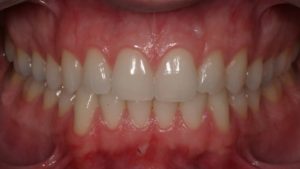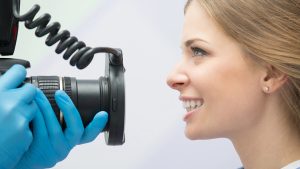If you want to take good dental photographs, you need to understand things like aperture, shutter speed, ISO, and white balance. Having your camera set to the proper settings will make all the difference between a great photo and a crappy photo. Let’s talk about camera settings for dental photography.
Disclaimer:
Hello and welcome to another video from the Comprehensive Dentist. My name is Dr. B, and today we are looking at camera settings. Now, out of the gate, I want to go ahead and put a little disclaimer on here, and that is, there are a lot of ways to take dental photographs. I have taught and studied dental photography for eight years now, and one thing I have noticed is a lack of consistency among instructors. Some people shoot in manual mode, and others shoot in aperture priority mode. Some like a shutter speed of 1/250th of a second, and others prefer 1/160th of a second. Some like to take full-face shots at an aperture of f/11, and others prefer an f-stop of 5.6. Some want to take intraoral pictures at f/22, and others prefer f/32. Those are not all the differences. Some prefer specific shots of patients for their photo series, and other providers capture entirely different photographs. So, what I tell you today is my take on dental photography camera settings, and I think you will find that my approach is practical and makes sense, but it’s not the only way. My process is to have a starting point for your photos, and then make adjustments to the settings to make the image better. As you take photos, the biggest thing we focus on when making adjustments is obtaining good exposure. I’ve even noticed that camera settings on my full-frame camera can be different if used on other cameras: other camera brands, full-frame versus crop sensor, different lenses, and various types of flashes are all contributing factors that influence the outcome of our photos. The settings that work on my camera may only be a good starting point for you. If you have the same camera, my settings will likely work very well, but my point is the camera settings we discuss are a starting point. If you understand aperture, shutter speed, ISO, and you know how to adjust the output on your flash, you will be able to fine-tune your camera to give you good quality consistent results. My recommendation is that you start with the settings I recommend, and then tweak the aperture, shutter speed, ISO, and flash as needed to get better results. So, let’s talk about the starting settings.
Starting Settings:
- Another thing that will be helpful is if you spend some time getting to know your camera. Go through the camera manual and learn what different camera parts can do, and how you adjust settings. There will only be a few things that we change when doing dental photography, and you need to know them solid. But it would be best if you learned as much about your camera as possible. As a starting point, read your manual and learn how to adjust aperture, shutter speed, ISO, and white balance.
Manual Mode:
- Your camera likely has various modes to shoot on. For dental photography, I recommend that you use manual mode. On a Canon camera, rotate the dial to select the letter ‚M,‘ which stands for manual. Manual mode will give us full control of our aperture and shutter speeds.
Image Quality:
- Image quality represents the file format you would like to save your image in. Enter the menu on the camera and find ‚image quality.‘ You can shoot in RAW, JPEG, or both. I shoot in RAW format, but many people prefer to shoot in JPEG. If you will shoot JPEG, make sure you choose the largest JPEG file size for the best quality.
Picture Style:
- The picture style represents preset styles in the camera with specific settings for sharpness, contrast, color saturation, and color tone. For dental photographs, I would recommend that you shoot in a standard picture style.
White Balance:
- The white balance is a setting where we set the temperature of the photo. Because we are using an external flash, the flash white balance setting would be appropriate. Alternatively, you could set the white balance to the daylight setting.
ISO:
- As you recall, the ISO is the sensitivity of the camera sensor to light. Set your ISO to the lowest possible setting. On a Canon camera, this would be 100. We want to keep this number low so we do not introduce grain or noise into our photographs. Since we will be using an external flash or twin flash, we will have plenty of light on our subject and not require a high ISO. Alternatively, you could leave this on auto mode. When I shoot dental photos with ISO set to auto, my ISO setting never goes above 400, which is still acceptable and will not introduce too much noise into the image.
Aperture:
- The aperture is a setting that will get changed the most as we progress through a photo series. For my photo series, I have extra-oral full-face images, extra-oral up-close images, and intraoral images that I take. For extra-oral full-face photos, I set my aperture to f/11, although any f-stop between 5.6 and 13 would be acceptable. Again, there are a lot of ways to approach this. For now, I would set your f-stop to f/11. So, if we use f/11 for extra-oral full-face images, what will we use as a starting point for extra-oral up-close and intraoral images? Well, for extra-oral up-close and intra-oral photos, I set my aperture to f/25 or higher. For now, use f/25 as a starting point.
Shutter Speed:
- A good starting point for your shutter speed will be 1/200th of a second. We may need to tweak this once we see how our photos are being exposed.
Autofocus:
- Autofocus can be appealing since it focuses for you. However, if your camera lacks a lot of focus points, it could result in unpredictable focus points where parts of your image are not in focus if you are not careful. I shoot all my dental pictures in manual focus and have specific points for each shot where I will focus. Especially when you are shooting intraoral photos, you will notice that the area that is in focus is very small when you look through the viewfinder. Even though only a tiny portion looks in focus through the viewfinder, when you take the photo, if your aperture is correct, all the essential parts of the photograph will be in focus. When we discuss technique for different images, I will tell you the recommended area to focus on so that your entire image has the best chance of being in focus where it matters.
Recap:
So, to recap the camera settings, remember, these are starting points. Once you take a photo, we will look at the image and the histogram and determine if it is underexposed, overexposed, or properly exposed. Our starting settings are:
- Manual mode
- Image quality set to RAW, JPEG, or both
- Picture style set to Standard
- White balance set to Flash or Daylight
- ISO set to as low as possible or on Auto
- Aperture set to f/11 for extra-oral full-face images and f/25 for extra-oral up-close and intraoral photos (these are starting points and may need adjustments)
- Shutter speed set to 1/200th of a second (may need adjustments)
- Autofocus set to manual
Again, these are just starting points, and you may need to tweak these settings on your camera to give you a proper exposure. Alright, now that you know some starting points for the camera settings, in the next video, we will talk about what photographs to take of your patients. I want to thank you for watching and learning, and I will see you next time.






